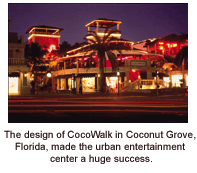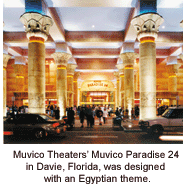DOES DESIGN COST,
OR PAY?
Roy Higgs
As planners and designers in the world of international architecture,
we face the same question nearly every day: "Does design cost, or pay?"
How does one place a value on creative, conceptual design in the overall
development of an entertainment destination?
In creating spaces that will continuously draw people to be entertained,
developers often consider the design element as an investment -- an investment
that must pay dividends. Obviously, without a return on investment, capital
invested in the design phase of a commercial development can be perceived
as wasted money. There is, of course, a cost; but if done well, the return
more than outweighs the cost. In evaluating this equation, it' best to
examine some examples of recent developments in which the design element
was considered an important investment to determine subsequent return
on investment.
The Appeal of Urban Entertainment
 In
1987, renowned developer Yaromir Steiner, who at the time
worked for Constructa, S.A., the original development company
of CocoWalk, was seeking to create a viable retail development
in the Florida town of Coconut Grove, near Miami. At the time,
Coconut Grove was an eclectic art and poetry community with
a bohemian nature that added considerable local color, but
it had never been able to sustain a sizable retail complex.
To succeed, the new complex would have to be designed in ways
that would attract people from nearby Miami, and that meant
giving them something they couldn't get closer to home. In
1987, renowned developer Yaromir Steiner, who at the time
worked for Constructa, S.A., the original development company
of CocoWalk, was seeking to create a viable retail development
in the Florida town of Coconut Grove, near Miami. At the time,
Coconut Grove was an eclectic art and poetry community with
a bohemian nature that added considerable local color, but
it had never been able to sustain a sizable retail complex.
To succeed, the new complex would have to be designed in ways
that would attract people from nearby Miami, and that meant
giving them something they couldn't get closer to home.
The challenge was to take 2 acres of vacant land in an area that couldn1t
attract retailers even if they were given the space, and show that with
the right plan, merchandising dynamics and urban design, it could work.
Consequently, a new approach was necessary, one that challenged prevailing
shopping center conventions. Drawing its inspiration from the villages
of the Mediterranean -- rather than prevailing, high-tech mall architecture
-- the design called for a three-story, tile-roofed, U-shaped complex of
boutiques, clubs, restaurants and caf s surrounding an open-air, palm
tree-lined courtyard. The project was designed with the intent of celebrating
the climate of South Florida, not hiding from it, as was conventional
wisdom at the time. There would be no conventional anchor. Instead, a
multi-screen cinema became the major draw, and circulation patterns were
structured to take advantage of its atypical location on the top floor.
When it opened in 1990, CocoWalk, as the project was called, became an
immediate success. In an industry that looks kindly on a sales average
of $250 per square foot, CocoWalk' average soared to more than $800.
It earned a first place award for innovative design from the International
Council of Shopping Centers and garnered an Award of Excellence from the
Urban Land Institute. Most significantly, CocoWalk helped usher in the
era of the urban entertainment center. It made shopping an experience
that appeals to the senses -- people go there because it' an event.
In the case of CocoWalk, design certainly paid -- and continues to pay
-- far more than it cost.
The Big Event at the Big Screen
Muvico Theaters, with wonderfully ornate megaplex entertainment centers
across the country, also understands and embraces the importance of the
design element as it relates to the success of its business. And the company
underscores the value in devoting significant intellectual resources to
architectural planning and design.
 Perhaps
the case that best exemplifies this concept -- design that
pays, not costs -- is Muvico Paradise 24, a cinema complex
in Davie, Florida. Muvico sought to create a movie theater
complex in a setting that would make it feel exotic and remote.
In exploring this request, the design team sought inspiration
from remote localities, including the wilderness and the ocean.
Finally, and perhaps most appropriately, the team settled
on the desert. Perhaps
the case that best exemplifies this concept -- design that
pays, not costs -- is Muvico Paradise 24, a cinema complex
in Davie, Florida. Muvico sought to create a movie theater
complex in a setting that would make it feel exotic and remote.
In exploring this request, the design team sought inspiration
from remote localities, including the wilderness and the ocean.
Finally, and perhaps most appropriately, the team settled
on the desert.
After melding the desert concept with the grandeur traditionally associated
with great theater, the team further developed the idea to arrive at an
Egyptian theme and a design reminiscent of a pharaoh' temple. The design
was bold, bordering on outlandish. But like good cinema, the plan carried
out the exotic theme, allowing moviegoers to suspend disbelief and enjoy
the fantasy world they had entered. After all, isn1t this one of the chief
intents of cinema?
Of course, the aesthetic appeal of the theater was obvious from the moment
the development was completed. The financial returns were realized a short
time later. Within weeks of the theater' opening in the spring of 1999,
Muvico Paradise 24 became one of the top 10 highest-grossing theaters
in the United States, and it has remained there. To Muvico, the answer
was clear: design pays.
By bringing back the "big event" experience enjoyed by the guests of
the great movie palaces of the 1920s and 1930s, each of Muvico' megaplexes
around the country indulges its guests with a total entertainment experience
from the moment they arrive. Muvico knows the answer to the question "Does
design cost, or pay?" From the magnificent entry fa•ades and colorful
hand-painted soaring atriums or domed rotunda lobbies to state-of-the-art
technology and curved wall-to-wall screens, lavishly designed movie complexes
demonstrate the answer in practice every day. From an architect or designer'
standpoint, the design can be nothing short of breathtaking. It not only
amplifies the experience of enjoying the finest in cinema, but also makes
an "event" of every trip to Muvico Theaters. Such design is a raised bar,
to be sure, but one to which a good designer enjoys aspiring.
And Pays and Pays and Pays . . .
Forward-thinking developers are embracing this notion in increasing numbers.
One of the latest tests of the design pays concept is the Atlantic Station
development in Atlanta. Atlantic Station will be a street-oriented retail
and entertainment destination that will also include office, residential
and hospitality components. The $2 billion project is a joint business
effort between Jacoby Development, Inc. and AIG Global Real Estate. The
partnership assembled a dream team of architects and designers dedicated
to creating a truly engaging space -- a mixed-use development that will
draw people in to live, work and play.
Once the site of the Atlanta Steel Hoop Company, the location' design
will play a principal role in the development' eventual success, both
in terms of tenancy and patronage. Preliminary plans call for a large
public town center with sidewalk caf s, fountains and a central park.
The "dream team," as Jacoby calls it, has shared the task of creating
design that will pay. Already the project has received considerable interest
from all segments of the market, resulting in agreements with many major
users. At its grand opening, planned for 2003, the development will yield
more than 3 million square feet of retail, office and residential space.
The redevelopment of this brownfield site presents unique challenges
for the design and development teams. Fortunately, regulators recognized
the site was a prime location for mixed-use development and worked with
the team to prepare the site. The site must now present itself as an alluring
destination for businesses, retailers and neighbors. In the case of Atlantic
Station, design plays not only an aesthetic role, but also an image re-creation
role. Without the ability to reshape people' image of a 100-year-old
steel manufacturing site, the development will struggle for viability
as a retail and entertainment destination. Hence, the "dream team." Perhaps
the expression would be better stated as, "Build it -- but design it well
-- and they will come."
At these and many other well-designed projects across the globe, developers
employ the design element to create a fantasy world, in a sense. The design
creates a space . . . an experience . . . a destination. Perhaps most
importantly, significant investment in design generates traffic, creating
a significant return on that investment. In the end, it is fulfillment,
even validation, for the entire architectural design industry, and the
pillar on which we, as designers, hang our hats.
Roy Higgs is CEO of Baltimore-based Development Design Group.
©2001 France Publications, Inc. Duplication
or reproduction of this article not permitted without authorization
from France Publications, Inc. For information on reprints of
this article contact Barbara
Sherer at (630) 554-6054.
|
